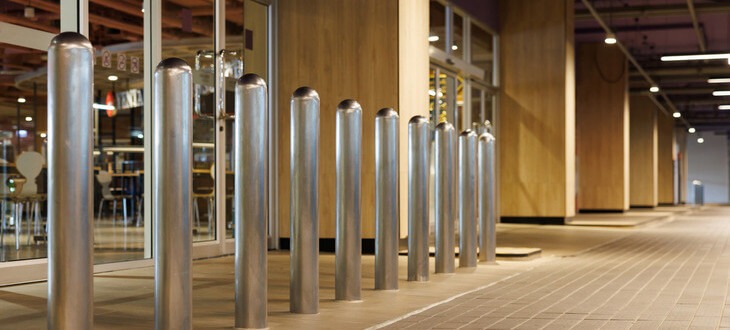Bollards are common in urban landscapes, parking lots, and around buildings. Yet their purpose and effectiveness might take time to be transparent to everyone. These sturdy posts are crucial in safety, security, and traffic management. In this blog post, we’ll delve into what bollards are, assess their effectiveness, explore their various uses, and provide tips on setting up bollards for maximum success.
What are Bollards Used For?
Bollards are short, vertical posts designed to control or direct road traffic, prevent vehicular access, or protect structures and pedestrians. They come in various materials, shapes, and sizes, each serving a different purpose.
- Fixed Bollards: Permanent installations typically made from steel or concrete.
- Removable Bollards: These can be temporarily removed for vehicle access.
- Retractable Bollards: Can be lowered into the ground to allow passage.
- Flexible Bollards: Bend upon impact and are often used in areas where vehicles frequently pass.
- Decorative Bollards: Designed to add aesthetic value while providing functionality.
The Brief History of Bollards
The concept of bollards dates back to ancient times when they were used as mooring posts for ships. Over the centuries, their role expanded to include traffic management and security functions, especially in urban environments.
Are bollards effective?
Assessing the Effectiveness of Bollards
The effectiveness of bollards depends on their intended use and proper installation. Here are some key points to consider:
- Safety: Bollards can protect pedestrians from vehicular accidents, especially in high-traffic areas.
- Security: They provide a physical barrier against vehicle-based attacks, enhancing security around sensitive buildings and infrastructure.
- Traffic Management: Bollards help control and direct traffic, preventing unauthorized access to restricted areas.
- Asset Protection: They safeguard structures, storefronts, and other assets from accidental or deliberate vehicle collisions.
Case Studies and Real-World Examples
- Urban Areas: Bollards are strategically placed in big cities like New York and London to protect pedestrians in busy areas and prevent vehicle-ramming attacks.
- Retail Stores: Large retailers often install bollards in front of their stores to prevent smash-and-grab thefts.
- Public Events: Temporary bollards are used to manage crowds and traffic during festivals and parades, ensuring the safety of attendees.
Common Applications of Bollards
Bollards are versatile and can be used in various settings:
- Pedestrian Safety: Install on sidewalks, pedestrian zones, and bike paths to create a safe environment.
- Building Protection: Place around the perimeter of buildings, especially those prone to vehicle accidents or attacks.
- Parking Management: Use in parking lots and garages to guide vehicles and protect structures.
- Traffic Control: Employ on roads to manage traffic flow, create lanes, and prevent unauthorized access.
- Aesthetic Enhancements: Use decorative bollards to enhance the visual appeal of public spaces, parks, and historical sites.
Specialized Uses of Bollards
There are many specialized uses for bollards, including:
- Industrial Sites: Protect critical infrastructure and equipment from vehicle collisions.
- Schools and Playgrounds: Ensure the safety of children by preventing vehicles from entering play areas.
- Maritime Settings: Modern versions of traditional mooring bollards secure boats and ships.
Setting Up Your Bollards for Success
To ensure bollards are effective, careful planning and strategic placement are essential:
- Assess the Area: Identify the location’s specific needs and potential threats.
- Determine the Purpose: Define whether the bollards are for security, safety, traffic management, or aesthetics.
- Choose the Right Type: Select bollards that best suit the identified needs—fixed, removable, retractable, or decorative.
Bollard Installation Tips
Proper installation is crucial for the effectiveness of bollards:
- Ensure Stability: Bollards should be securely anchored to withstand impact. Concrete footings are often used for permanent installations.
- Follow Regulations: Adhere to local regulations and standards regarding bollard installation, especially in public spaces.
- Consider Visibility: Bollards should be highly visible to drivers and pedestrians to prevent accidents.
Maintenance and Inspection for Bollards
Regular maintenance and inspection are vital to ensure bollards remain functional:
- Inspect for Damage: Regularly check bollards for signs of wear or damage and repair or replace them as needed.
- Clean and Maintain: Keep bollards clean to maintain visibility and aesthetic appeal, especially decorative ones.
- Test Retractable and Removable Bollards: Ensure that movable bollards function correctly and can be easily operated when needed.
Bollards are highly effective tools for enhancing safety, security, and traffic management in various settings. Their applications are diverse and essential, from protecting pedestrians and buildings to managing vehicle traffic and adding aesthetic value. Understanding what bollards are, their effectiveness, and how to set them up properly can help you make informed project decisions.
Visit Tampa Steel & Supply for Quality Metal and Metal Processing Services
Do you need help with metalworking and keeping your metal fresh? The experienced professionals at Tampa Steel & Supply are here to help. We provide the highest quality of services to our customers.
Request a Quote Online
Or Call Tampa Steel & Supply at (813) 241-2801

